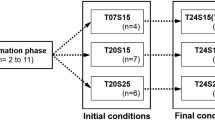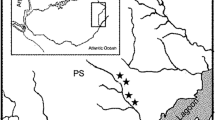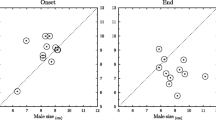Abstract
The importance of sexual selection for the evolution, dynamics and adaptation of organisms is well known for many species. However, the topic is rarely studied in marine plankton, the basis of the marine food web. Copepods show behaviors that suggest the existence of sexually selected traits, and recent laboratory experiments identified some selected morphological traits. Here, we use a ‘life history-based’ model of sex roles to determine the optimal choosiness behavior of male and female copepods for important copepod traits. Copepod females are predicted to be choosy at population densities typically occurring during the main breeding season, whereas males are not. The main drivers of this pattern are population density and the difference in non-receptive periods between males and females. This suggests that male reproductive traits have evolved mainly due to mate competition. The model can easily be parameterized for other planktonic organisms, and be used to plan experiments about sexual selection.




Similar content being viewed by others
References
Ali AK, Primicerio R, Folstad I, Liljedal S, Berge J (2009) Morphological correlates of mating frequency and clutch size in wild caught female Eudiaptomus graciloides (Copepoda: calanoida). J Plankton Res 31:389–397
Anstensrud M (1990) Mating strategies of two parasitic copepods [(Lernaeocera branchialis (L.)(Pennellidae) and Lepeophtheirus pectoralis (Müller)(Caligidae)] on flounder: polygamy, sex- specific age at maturity and sex ratio. J Exp Mar Biol Ecol 136:141–158
Arnqvist G, Nilsson T (2000) The evolution of polyandry: multiple mating and female fitness in insects. Anim Behav 60:145–164
Bagøien E, Kiørboe T (2004) Blind dating - mate finding in planktonic copepods. III. Hydrome- chanical communication in Acartia tonsa. Mar Ecol Prog Ser 300:129–133
Blades P (1977) Mating behavior of Centropages typicus (Copepoda: calanoida). Mar Biol 40:57–64
Burton RS (1985) Mating system of the intertidal copepod Tigriopus californicus. Mar Biol 86:247–252
Buskey E, Lenz P, Hartline D (2002) Escape behavior of planktonic copepods in response to hydrodynamic disturbances: high speed video analysis. Mar Ecol Prog Ser 235:135–146
Ceballos S, Kiørboe T (2010) First evidences of sexual selection by mate choice in marine zooplankton. Oecologia 164:627–635
Ceballos S, Kiørboe T (2011) Senescence and sexual selection in a pelagic copepod. PLoS ONE 6:e18870
ChapmanT Liddle L, Kalb J, Wolfner M, Partridge L (1995) Cost of mating in Drosophila melanogaster females is mediated by male accessory-gland products. Nature 373:241–244
Corkett CJ, McLaren IA (1969) Egg production and oil storage by the copepod Pseudocalanus in the laboratory. J Exp Mar Biol Ecol 3:90–105
Corkett CJ, McLaren IA (1978) The biology of Pseudocalanus. Adv Mar Biol 15:1–231
Cornwallis CK, Uller T (2010) Towlatter faces a significantly elevated ards an evolutionary ecology of sexual traits. Trends Ecol Evol 25:145–152
Digby PSB (1950) The biology of the small planktonic copepods of Plymouth. J Mar Biol Assoc UK 29:393–438
Doall M, Colin S, Strickler J, Yen J (1998) Locating a mate in 3D: the case of Temora longicornis. Philos Trans R Soc Lond B 353:681–689
Fleminger A (1985) Dimorphism and possible sex change in copepods of the family Calanidae. Mar Biol 88:273–294
Fowler K, Partridge L (1989) A cost of mating in female fruitflies. Nature 338:760–761
Gusmao LFM, McKinnon AD (2009) Sex ratios, intersexuality and sex change in copepods. J Plankton Res 31:1101–1117
Hirst A, Kiørboe T (2002) Mortality of marine planktonic copepods: global rates and patterns. Mar Ecol Prog Ser 230:195–209
Hirst AG, Sheader M, Williams JA (1999) Annual pattern of calanoid copepod abundance, prosome length and minor role in pelagic carbon flux in the Solent, UK. Mar Ecol Prog Ser 177:133–146
Hirst A, Bonnet D, Conway D, Kiørboe T (2010) Does predation control adult sex ratios and longevities in marine pelagic copepods? Limnol Oceanogr 55:2193–2206
Humes AG (1994) How many copepods? Hydrobiologia 292–293:1–7
Hylstofte Sichlau M, Kiørboe T (2011) Age- and size-dependent mating performance and fertility in a pelagic copepod, Temora longicornis. Mar Ecol Prog Ser 442:123–132
Ianora A, Miralto A, Buttino I, Romano G, Poulet SA (1999) First evidence of some dinoflagellates reducing male copepod fertilization capacity. Limnol Oceanogr 44:147–153
Irigoien X, Obermüller B, Head RN, Harris RP, Rey C, Hansen BW, Hygum BH, Heath MR, Durbinal EG (2000) The effect of food on the determination of sex ratio in Calanus spp.: evidence from experimental studies and field data. ICES J Mar Sci 57:1752–1763
Jennions MD, Petrie M (1997) Variation in mate choice and mating preferences: a review of causes and consequences. Biol Rev 72:283–327
Jennions MD, Petrie M (2000) Why do females mate multiply? A review of the genetic benefits. Biol Rev Cambridge Philos Soc 75:21–64
Katona SK (1973) Evidence for sex pheromones in planktonic copepods. Limnol Oceanogr 18:574–583
Kiørboe T (2007) Mate finding, mating, and population dynamics in a planktonic copepod Oithona davisae: there are too few males. Limnol Oceanogr 52:1511–1522
Kiørboe T (2008) Optimal swimming strategies in mate-searching pelagic copepods. Oecologia 155:179–192
Kiørboe T, Bagoien E (2005) Motility patterns and mate encounter rates in planktonic copepods. Limnol Oceanogr 50:1999–2007
Kiørboe T, Visser AW (1999) Predator and prey perception in copepods due to hydromechanical signals. Mar Ecol Prog Ser 179:81–95
Kiørboe T, Bagoien E, Thygesen U (2004) Blind dating—mate finding in planktonic copepods. II. The pheromone cloud of Pseudocalanus elongatus. Mar Ecol Prog Ser 300:117–128
Kokko H, Monaghan P (2001) Predicting the direction of sexual selection. Ecol Lett 4:159–165
Kokko H, Rankin D (2006) Lonely hearts or sex in the city? Density-dependent effects in mating systems. Philos Trans R Soc Lond B 361:319–334
Korpelainen H (1990) Sex ratios and conditions required for environmental sex determination in animals. Biol Rev Cambridge Philos Soc 65:147–184
Landry MR (1978) Population dynamics and production of a planktonic marine copepod, Acartia clausii, in a small temperate lagoon on San Juan Island, Washington. Int Rev Ges Hydrobiol 63:77–119
Lee WY, McAlice B (1979) Seasonal succession and breeding cycles of three species of Acartia (Copepoda: calanoida) in a Maine estuary. Estuar Coast 2:228–235
Maly EJ (1973) Density, size, and clutch of two high altitude diaptomid copepods. Limnol Oceanogr 18:840–848
Mauchline J (1998) The biology of calanoid copepods. Academic, London
Möllmann C, Köster F (2002) Population dynamics of calanoid copepods and the implications of their predation by clupeid fish in the Central Baltic Sea. J Plankton Res 24:959–977
Renz J, Mengedoht D, Hirche H (2008) Reproduction, growth and secondary production of Pseudocalanus elongatus Boeck (Copepoda, Calanoida) in the southern North Sea. J Plankton Res 30:511–528
Rodriguez J, Mullin MM (1986) Relation between biomass and body weight of plankton in a steady state oceanic ecosystem. Limnol Oceanogr 31:361–370
Schluter D (2001) Ecology and the origin of species. Trends Ecol Evol 16:372–380
Sheldon RW, Prakash A, Sutcliffe WH Jr (1972) The size distribution of particles in the ocean. Limnol Oceanogr 17:327–340
Shimanaga M, Shirayama Y (2005) Precopulatory mate guarding of interstitial Phyllopodopsyllus sp. (Copepoda: harpacticoida) in Otsuchi Bay, Northeastern Japan. Benthos Res 60:39–40
Shuster SM, Wade MJ (2003) Mating systems and strategies. Princeton University Press, Princeton
Smyly WJP (1968) Number of eggs and body size in the freshwater copepod Diaptomus gracilis Sars in the English Lake District. Oikos 19:323–338
Titelman J, Varpe Ø, Eliassen S, Fiksen Ø (2006) Copepod mating: chance or choice? J Plankton Res 29:1023–1030
Tsuda A, Miller C (1998) Mate-finding behaviour in Calanus marshallae Frost. Philos Trans R Soc Lond B 353:713–720
Uchima M (1985) Copulation in the marine copepod Oithona davisae. I. Mate discrimination. Bull Plankton Soc Jpn 32:23–30
Uye S, Sano K (1995) Seasonal reproductive biology of the small cyclopoid copepod Oithona davisae in a temperate eutrophic inlet. Mar Ecol Prog Ser 118:121–128
Visser AW, Mariani P, Pigolotti S (2009) Swimming in turbulence: zooplankton fitness in terms of foraging efficiency and predation risk. J Plankton Res 31:121–133
Wilson D, Parrish K (1971) Remating in a planktonic marine calanoid copepod. Mar Biol 9:202–204
Yen J, Weissburg M, Doall M (1998) The fluid physics of signal perception by mate-tracking copepods. Philos Trans R Soc Lond B 353:787–804
Acknowledgments
Ken Anderson and Uffe Høgsbro Thygesen for help with error-functions; Sara Ceballos and Mie Hylstofte Sichlau for input data, and Øyvind Fiksen for discussions, as well as anonymous referees for constructive comments. J.H. was funded by a DFG Research Fellowship (grant number HE 6050/1-1).
Author information
Authors and Affiliations
Corresponding author
Additional information
Communicated by Craig Osenberg.
Electronic supplementary material
Below is the link to the electronic supplementary material.
Rights and permissions
About this article
Cite this article
Heuschele, J., Eliassen, S. & Kiørboe, T. Optimal mate choice patterns in pelagic copepods. Oecologia 172, 399–408 (2013). https://doi.org/10.1007/s00442-012-2516-4
Received:
Accepted:
Published:
Issue Date:
DOI: https://doi.org/10.1007/s00442-012-2516-4




